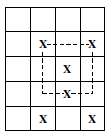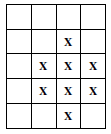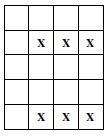The game of Life, invented by John Conway, is supposed to model the genetic laws for birth, survival, and death (see Scienti_c American, October 1970, p. 120). We will play it on a board with a maximum of 60 squares (i.e. columns) in the horizontal direction and a maximum of 20 squares (i.e. rows) in the vertical direction. Each square can be empty or contain an X indicating the presence of an organism. The small dashed square shown in the segment of the board drawn below connects all the neighbors of the organism in row 3, column 3 (note that the upper left corner cell on the board is at location row 1, column 1).

The next generation of organisms is determined according to the following criteria:
Birth An organism will be born in each empty location that has exactly three neighbors.
Death An organism with four or more organisms as neighbors will die from overcrowding. An organism with fewer than two neighbors will die from loneliness.
Survival An organism with two or three neighbors will survive to the next generation.
Generations 2 and 3 for the sample follow:

Generation #2 Generation #3

Note that each new generation is computed only from the data in the previous generation. In other words, when considering a cell's neighbors you only use the information on the previous generation, not the data (organisms) in the current generation you are computing.
You should allow for a minimum game board of 3 rows by 3 columns and a maximum size of 20 rows by 60 columns. Read in an initial configuration of organisms from a text data _le
(specified on the command line with the _le name echo printed to the screen; do not make any assumptions about the name of this _le) with the following format:

Any data, characters, or blank lines that might follow the '0 0' sentinel value pair should be ignored.
Use the following algorithm as a starting point for writing your simulation:
initialize the board to empty (i.e. no organisms)
set generation equal to 1
input starting board from data _le
write board to screen and pause
repeat
increment generation by 1
compute the next generation
write new generation to screen and pause
until _nished
Be sure to subdivide your code into appropriate methods as discussed in class.
All inputed data must be in the ranges indicated; any erroneous data should be reported to the user and a fatal exception (of type java.lang.RuntimeException; see below) should be raised. Each board should be printed in text mode (i.e. do not use graphics and/or separate windows|you must use print, println, or printf to produce your output) and should be labeled with its generation number, with the initial con_guration labeled as generation 1.
You should number the rows and columns in the manner shown in the examples (especially note the numbering in the second sample run below) that follow plus print a boundary around each board (using the +, -, and | characters) and use the X (capital x) character to represent organisms, e.g. the Generation 1 board on the previous page would be drawn like this:
1234
+----+
1| |1
2| X X|2
3| X |3
4| X |4
5| X X|5
+----+
1234
(Note that there are no blank rows in the example given; this board is printed using 9 rows total, counting the numbering and borders.) You should also pause between printing each generation, continuing only when the user presses the ENTER key; make sure they are prompted to press enter to continue (probably the easiest way to do this is by just calling the nextLine() method in the Scanner class).
Exceptions can be raised using the following code:
if ( some_condition ) throw new java.lang.RuntimeException("your error message goes here"); where some condition is the boolean error condition you are checking for, and the string passed to the constructor for java.lang.Exception should be some appropriate error message to the user.
2 Sample Runs
The following are only partial sample runs.
2.1 Sample Run #1
Data _le life2.dat:
3
3
5
1 2
3
2 2
3 2
0 0
Sample run:
liberty:~/javaprogs/% java Life2012 life2.dat
Game of Life (with board wrap)
D. Resler 2/99 [2012]
Opened file: life2.dat
Generation 1:
123
+---+
1| X |1
2| X |2
3| X |3
+---+
123
(press enter to continue)
Generation 2:
123
+---+
1| |1
2|XXX|2
3| |3
+---+
123
(press enter to continue)
Generation 3:
123
+---+
1| X |1
2| X |2
3| X |3
+---+
123
4
(press enter to continue)
Generation 4:
123
+---+
1| |1
2|XXX|2
3| |3
+---+
123
(press enter to continue)
Generation 5:
123
+---+
1| X |1
2| X |2
3| X |3
+---+
123
(press enter to continue)
liberty:~/javaprogs/%
2.2 Sample Run #2
Data _le lifeHandout.dat:
20
60
20
6 27
6 29
7 27
7 29
8 27
8 28
8 29
0 0
Sample run:
liberty:~/javaprogs/% java Life2012 lifeHandout.dat
Game of Life (with board wrap)
D. Resler 2/99 [2012]
(press enter to continue) (More would follow { not a complete run!)
3 Deliverables
You are to turn in your project through the project submission form on the class web page. Name your source code _le Proj7XXXX.java where XXXX is the last 4 digits of your student id number (and your class should therefore be named Proj7XXXX).